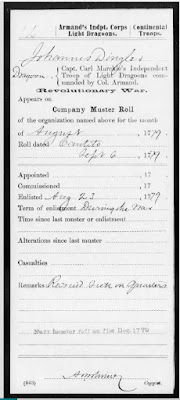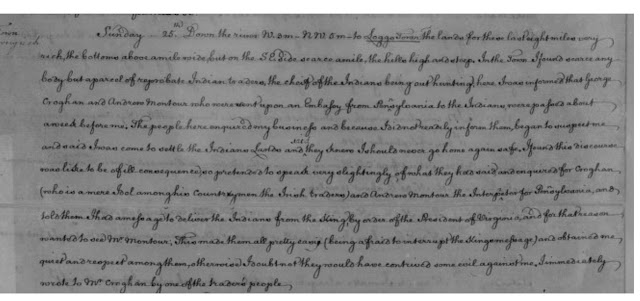 |
| by Don Troiani from flintlockandtomahawk.blogspot.fi |
When John Dingler died in 1816 Morgan County, Georgia he was a well-respected Baptist preacher. Yet, when he arrived in America in 1776 or 1777 he was a highly skilled Jäger (known as chasseurs or sharpshooters in English) from the German state of Hessen-Kassel fighting with the British troops against American patriots. We have come to call these soldiers "Hessian mercenaries," a derogatory term, but upon further exploration of the literature much more is revealed.
According to a paper entitled "Campaigning in America: Captain Johann Ewald's Hessians in the American Revolution" by Gregory D. Bereiter "unlike soldiers of field and garrison regiments, the Jägers 'had to be men of sufficient reliance and intelligence' to work in smaller units engaged in scouting and patrolling, as they so often did in America. More importantly though, the Jägers were volunteers and professionals. And although the Jägers numbered slightly over 1,000 troops...they performed duties that were quite disproportionate to their small numbers." It should also be remembered that the soldiers themselves were not the mercenaries - that name can only be applied to Landgraf Friedrich II von Hessen-Kassel who was the one to receive money for their services from the English king.
The only records I have found, so far, that place Johannes in the German corps are from AM_REV Hessian mailing list and the Journal of the Johannes Schwalm Historical Association that list him under the heading: Hessen - Kassel soldiers settled in USA after 1783: Dingeler, Johannes, Hesse-Cassel; Seyboldsdorf; Private; Jaeger Co. 3; HETRINA Vol IV; Deserted 20 Aug. 1779 probably near NYC.
Armed with this information I then turned to the military records of the American troops, looking through the Revolutionary War Rolls of the National Archives that are online at Fold3. I located Johannes, serving under Charles Armand Tuffin, Marquis de la Rouërie - a French military officer serving under General George Washington. This unit was called Armand's Independent Corps of Light Dragoons. The muster roll shown here states that Johannes enlisted the 23rd of August 1779. Excellent information as my next step would be to track Armand's movements at that time.
I found that he was engaged in many skirmishes with the British-led troops in the Westchester County, New York area during the summer and fall of 1779. My research has now shown that the Jaeger companies were often overlapping with each other and finding out who was in command of my Jäger, Johannes, is proving difficult. I do think that this event is when he decided to desert - as it was only three days prior to his enlistment with Armand's dragoons who were in the area at the time (and possibly involved in this particular event).
Captain Johann Ewald was in charge of the 2nd company of Jägers and he kept a journal of his activities while in America. From his account I find that on the 20th of August 1779, he "lost" over twenty of his men while aiding Lt. Col. Emmerich near Eastchester in Westchester County. Ewald also states that Armand was in the area. Based upon my research, I believe this was the time and place Johannes deserted from the British in order to join up with the American troops.
Such action was not unusual. The U.S. Congress offered fifty acres of land to any Hessian deserter that joined the American troops. That may have been Johannes' only reason, we will never know. Perhaps, he had little back in Germany to encourage him to return. Perhaps, he was caught up in the American ideals of democracy and the patriots' commitment to build a new country based upon these ideals. I like to think it was the latter.
Armand disbanded his legion November of 1783 in Philadelphia. Prior to that his troops were in the South - Virginia and the Carolinas. In a letter to Washington in September of that year, Armand outlines a plan in which "congress would give to the legion under his command the lands on the other side of Ohio, in the proportion which has been promissed to the army in general...that at the same time the legion be ordered to march in the settled parts of the country as near as possible of the land where they are to settle...that from the time they shall be able to go on those land a year rations be allowed to them."[emphasis mine]. I do not know if this happened or not, but the first record I have found so far for Johannes as John Dingler, the American, is 1782 in Warren County, North Carolina. He is listed as owing tax money - he is an "insolvent." (Warren County North Carolina Will Book 3 p190+ ). Not a great start for my Jäger in America but things do improve. His son, my ancestor, is Samuel Dennis Dingler and he was born circa 1786 in Georgia according to his 1850 census record. By 1793, the John Dingler family is in Elbert County, Georgia and are listed a few years later as members of the Church of Christ at Van's Creek, Elbert County, Georgia.
So often with historical research a new question arises each time a new clue is found. There is always more to learn and more ways to approach the problem. That is exactly the draw for me because I know each research effort will reveal more about my ancestors' lives and their part in the larger historical story.
Such action was not unusual. The U.S. Congress offered fifty acres of land to any Hessian deserter that joined the American troops. That may have been Johannes' only reason, we will never know. Perhaps, he had little back in Germany to encourage him to return. Perhaps, he was caught up in the American ideals of democracy and the patriots' commitment to build a new country based upon these ideals. I like to think it was the latter.
Armand disbanded his legion November of 1783 in Philadelphia. Prior to that his troops were in the South - Virginia and the Carolinas. In a letter to Washington in September of that year, Armand outlines a plan in which "congress would give to the legion under his command the lands on the other side of Ohio, in the proportion which has been promissed to the army in general...that at the same time the legion be ordered to march in the settled parts of the country as near as possible of the land where they are to settle...that from the time they shall be able to go on those land a year rations be allowed to them."[emphasis mine]. I do not know if this happened or not, but the first record I have found so far for Johannes as John Dingler, the American, is 1782 in Warren County, North Carolina. He is listed as owing tax money - he is an "insolvent." (Warren County North Carolina Will Book 3 p190+ ). Not a great start for my Jäger in America but things do improve. His son, my ancestor, is Samuel Dennis Dingler and he was born circa 1786 in Georgia according to his 1850 census record. By 1793, the John Dingler family is in Elbert County, Georgia and are listed a few years later as members of the Church of Christ at Van's Creek, Elbert County, Georgia.
So often with historical research a new question arises each time a new clue is found. There is always more to learn and more ways to approach the problem. That is exactly the draw for me because I know each research effort will reveal more about my ancestors' lives and their part in the larger historical story.




